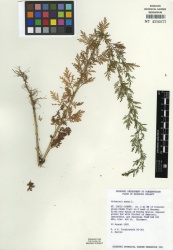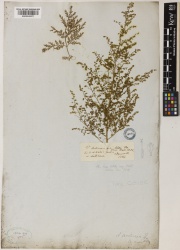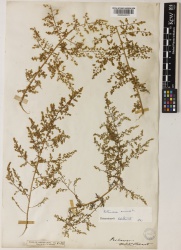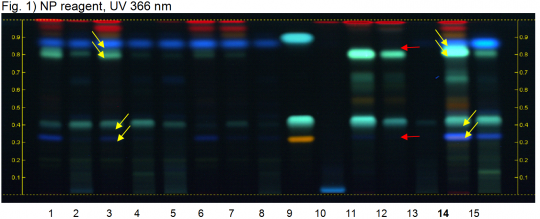Artemisia annua (leaf)
Contents |
Nomenclature
Artemisia annua L. Asteraceae
Standardized common name (English): sweet wormwood
Pinyin name(s): huang hua hao; qing hao (aboveground parts)
Botanical Voucher Specimen
 |
 |
||
|
|
|
|
|
Organoleptic Characteristics
Macroscopic Characteristics
Microscopic Characteristics
High Performance Thin Layer Chromatographic Identification
|
Sweet wormwood (leaf), qing hao (leaf) (Artemisia annua) Lane Assignments Lanes, from left to right (Track, Volume, Sample):
Reference Sample(s) Reference: Dissolve 1 mg of chlorogenic acid in 1 mL of methanol, Dissolve 1 mg of caffeic acid in 1 mL of methanol, Optional: Dissolve 1 mg of rutin in 1 mL of methanol. Stationary Phase Stationary phase, i.e. Silica gel 60, F254 Mobile Phase Ethyl acetate, water, acetic acid, formic acid 100:26:11:11 (v/v/v/v) Sample Preparation Method Sample: Mix 500 mg of powdered sample with 5 mL of methanol and sonicate for 10 minutes, then centrifuge or filter the solutions and use the supernatants / filtrates as test solutions. Derivatization reagent: NP reagent, Preparation: 1 g of natural products reagent in 200 mL of ethyl acetate, Use: Heat plate for 3 min at 100°C, then dip (time 0, speed 5). Detection Method Saturated chamber; developing distance 70 mm from lower edge; relative humidity 33% Other Notes Images presented in this entry are examples and are not intended to be used as basis for setting specifications for quality control purposes. System suitability test: Chlorogenic acid: green fluorescent zone at Rf ~ 0.40. Caffeic acid: green fluorescent zone at Rf ~ 0.90. Identification: Compare result with reference images. The fingerprint of the test solution is similar to that of the corresponding botanical reference sample. Additional weak zones may be present. The chromatogram of the test solution shows a green fluorescent zone at Rf ~ 0.40 corresponding to reference chlorogenic acid and below it a blue zone at Rf ~ 0.32 (yellow arrows). In the upper part of the chromatogram there is an intense green zone at Rf ~ 0.81 and a blue one just above it at Rf ~ 0.86. Below the solvent front there are two red zones. Similar but fainter zones are seen in the fresh sample (track 3). Test for adulteration: The blue zones at Rf ~ 0.32 and Rf ~ 0.86 are missing (red arrows, Chinese wormwood leaf).
|
Supplementary Information
Sources
- ↑ MOBOT, Tropicos.org http://www.tropicos.org/Image/88841
- ↑ MOBOT, Tropicos.org
- ↑ Royal Botanic Gardens, Kew. http://specimens.kew.org/herbarium/K000942071
- ↑ Royal Botanic Gardens, Kew. http://specimens.kew.org/herbarium/K000942072
- ↑ HPTLC Association http://www.hptlc-association.org/




